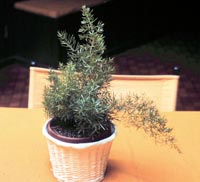Resource Library
Plant of the Week: Fern, Asparagus
The University of Arkansas System Division of Agriculture does not promote, support or recommend plants featured in "Plant of the Week." Please consult your local Extension office for plants suitable for your region.
Plant of the Week
Asparagus Fern
Latin: Asparagus densiflorus 'Sprengeri'

Asparagus fern is not a fern at all, but a member of the lily family. It is a close relative of true asparagus and is edible. Undoubtedly, when Barbie invites Ken over for a dinner party, she serves miniature asparagus fern spears lightly coated with a delicate Hollandaise sauce. A century ago this was "one of the most popular basket and decorative plants" and remains so today. Obviously this faker has more to offer than the average imposter.
The plant, collected in Natal Province, South Africa, was introduced to the trade in 1890 by an Italian seed company called Dammann and Co., which named the plant after their collector Herr Sprenger, at least according to Bailey’s 1900 "Cyclopedia of American Horticulture." By 1914, when Bailey published the "Standard Cyclopedia of Horticulture," the reference to commercial introduction was omitted, so there may be an earlier claimant to the plant, but no doubt it did enter the trade during the later years of the 19th century.
Like our garden asparagus, the asparagus fern is a perennial in milder parts of the country. It will reliably overwinter in protected beds in southern Arkansas in Zone 8. It forms a greenish white tuber that looks just like a Thompson seedless grape -- another bit of fakery the plant employs to get through the winter. When it emerges in the spring the shoots grow rapidly and form arching canes that are clothed in inch-long fake leaves called cladophylls. The cladophylls are actually modified branchlets while the true leaves take the form of small, soft spines.
In late summer, plants that are at least a year old typically produce quarter inch white, fragrant flowers followed by pea-sized red berries later in the year. The seeds sprout readily and are the most reliable means of propagation, although old plants can be divided. Asparagus ferns can attain great age and become family heirlooms.
Asparagus ferns are ideal for the patio where they are well suited for use in hanging baskets, mixed planters or in individual pots. The cut stems may also be used as greenery in flower arrangements. They grow best in bright locations with a uniform supply of moisture. The plants have great drought tolerance but they drop their modified leaves and stop growing when they get too dry. Plants can be kept over winter indoors by locating in the brightest possible location and keeping them slightly on the dryer side.
By: Gerald Klingaman, retired
Extension Horticulturist - Ornamentals
Extension News - February 25, 2000
The University of Arkansas System Division of Agriculture does not maintain lists of retail outlets where these plants can be purchased. Please check your local nursery or other retail outlets to ask about the availability of these plants for your growing area.